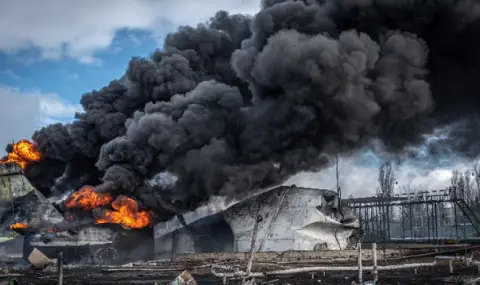Since the beginning of the year, Ukraine has attacked Russian oil infrastructure facilities at least 64 times, according to the BBC Russia Service.
According to the information, it is primarily about oil refineries and oil depots. In at least 49 cases, authorities or Russian Telegram channels reported fires following such attacks. Many were extinguished on the same day, but there are exceptions, such as the fire at the oil depot in Proletarsk.
In addition, two attacks followed by fires were recorded in Russian-occupied Lugansk.
Approximately a quarter of all attacks (17) took place in Krasnodar Krai, with Rostov Oblast (five incidents) coming in second by a wide margin.
One of the longest fires after such an attack has been extinguished for the sixth day already at an oil base in the city of Proletarsk, Rostov region. Smoke from the fire as of August 22 extended, according to BBC estimates, more than 80 km in Copernicus Sentinel satellite images.
On August 22, another significant attack was carried out in the port of Kavkaz, near the Crimean bridge, for which the Ukrainian Navy claimed responsibility. As a result of this attack, a railway ferry carrying 30 tanks of fuel was damaged and probably sank.
Russian oil infrastructure facilities are generally a logical target for such attacks. The income from the sale of oil and gas is one of the main sources for replenishing the Russian budget.
There is currently a ban on the export of gasoline to Russia. The authorities introduced it on March 1 amid rising gasoline prices in the domestic market, but at the end of May it was the ban was lifted for just over two months. The ban was originally supposed to end in September, but the authorities decided to extend it until the end of the year.
Gasoline prices in Russia started to rise in the spring amid a cut in its production. The reason is repairs at some refineries, as well as drone attacks on others. It is true that it is difficult to assess the damage from the attacks - oil companies usually do not disclose how long it takes them to repair the plants and how much they have to cut production.
The situation on the gasoline market still remains tense, which is why the authorities are restricting exports. In addition, the prices of logistics, i.e. the transportation of various goods and services depend on gasoline prices.
Product manufacturers have already warned retail chains about a possible increase in food prices, writes the Russian newspaper "Kommersant". They attributed these decisions to, among other things, rising logistics costs.
From a military point of view, these attacks make sense, because refineries and other fuel and energy plants are quite easy to hit with a drone - they stand in one place, occupy a large area, with many vulnerable places. But the main thing is that they are very weakly protected.
In the spring of 2024, as the campaign to attack Russia's oil and gas infrastructure gathered pace, the press discussed the possibility of protecting enterprises with Pantsir S1 anti-aircraft systems. In this case, they will have to be removed from other objects, weakening their air defense.
Since then, however, judging by press publications, little has changed in the protection of fuel facilities. Armor apparently remained at the front and at strategic sites. It is true that tanks at some refineries have begun to be covered with anti-drone nets, but judging by recent events, they are not of much use.
